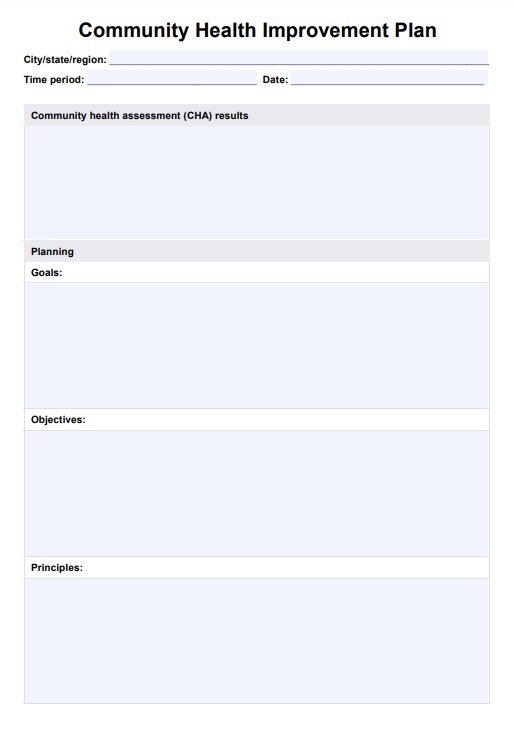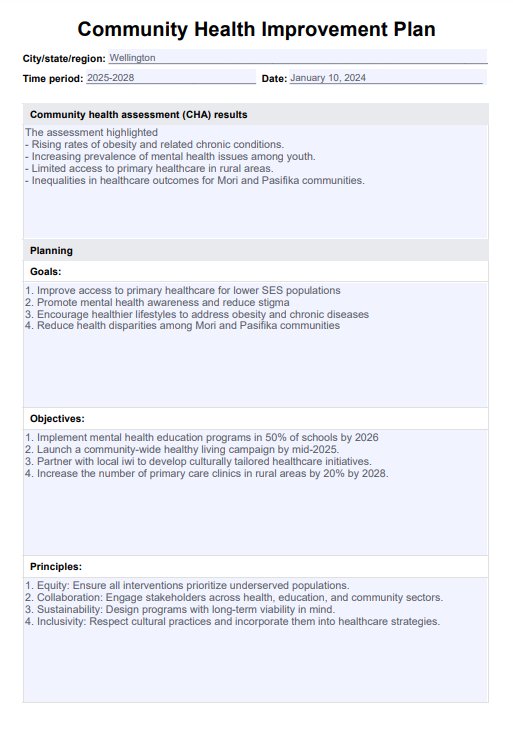Community Health Improvement Plan
Use our Community Health Improvement Plans (CHIPs) template to address community health needs strategically.


What is a Community Health Improvement Plan?
A Community Health Improvement Plan (CHIP), or community health improvement process, is a strategic plan developed based on a community health assessment (CHA) or community health needs assessment (CHNA) (Centers for Disease Control and Prevention, 2024). This Community Health Improvement Plan outlines the priorities, strategies, and actions needed to address the health needs and improve the health status of a community or region. It utilizes local public health systems and community planning for health to guide these efforts effectively.
The CHIP process involves collaboration among stakeholders, including community partners, health services providers, local and state health department departments, organizations, and residents. It utilizes data and analysis from the community health assessments to identify critical health issues, disparities, and areas of need within the community.
Key components of a CHIP include:
- Assessment: Utilizing data from community health assessments to identify the community's health needs, resources, and priorities.
- Analysis: Analyzing the data to understand the underlying factors contributing to health issues and disparities.
- Community engagement: Involving community members and stakeholders in the planning process to ensure that the CHIP reflects the community's vision and priorities.
- Development of strategies: Developing evidence-based strategies and interventions to address the identified health needs and priorities.
- Partnerships: Establishing partnerships and collaborations with community organizations, health services providers, and other stakeholders to support the implementation of the CHIP.
- Implementation: Implementing the strategies outlined in the CHIP through coordinated efforts and allocation of resources.
- Monitoring and evaluation: Continuously monitor progress and evaluate the impact of the CHIP to ensure that it effectively addresses the community's health needs and achieves its goals.
The CHIP serves as a roadmap for improving the community's public health, guiding the allocation of resources and efforts toward the most pressing public health issues. It is informed by the principles of public health, including equity, community engagement, and evidence-based practice, and aims to create healthier and more resilient communities.
Community Health Improvement Plan Template
Community Health Improvement Plan Example
How to use the Community Health Improvement Plan template?
Using the provided Community Health Improvement Plan template is simple and straight forward, follow these steps to get started:
Step 1: Download template
Access the Community Health Improvement Plan template by clicking "Use a template," allowing you to edit the resource via the Carepatron app. For a PDF copy, choose "Download."
Step 2: Conduct a community health assessment
This is the basis of the Community Health Improvement Plan, therefore it is important to take the time to get as much accurate and relevant data as possible from a variety of sources and stakeholders.
Step 3: Planning
Given the results from the CHA, work through the different sections of the CHIP, ensuring to consider different perspectives and ideas on each of the topics. It is beneficial at this point to consult with other community members to get different opinions and perspectives.
Step 4: Implement
Create detailed plans for the next 3-5 years focusing on goals, objectives, priorities, and funding options. Implement the plan into the community.
Step 5: Evaluation
Review evidence alongside consulting with stakeholders and community members to measure progress. Be open to criticism and feedback, adapting the CHIP if necessary to better reflect the community.
Community Health Improvement Plan process
Developing a Community Health Improvement Plan (CHIP) involves several key steps. Here's an overview of the process:
Assessment
Firstly conduct a community health assessment. This territorial health assessment identifies key health needs in relation to health risks and outcomes, community needs, health disparities, and available resources (Dayton & Montgomery County, 2022). During this process it is important to engage community members, stakeholders, public health accreditation board and partners in the assessment process to ensure that diverse perspectives are considered and community priorities are identified.
Planning
Based on the findings of the CHA, the next step is to prioritize them and establish clear goals, principles, and objectives for a CHIP. Develop specific, measurable, achievable, relevant, and time-bound goals and objectives to address the identified priorities. Develop evidence-based strategies and interventions to achieve the goals and objectives. Consider the input of stakeholders and community members in selecting and designing interventions. Establish partnerships with community organizations, healthcare providers, government agencies, and other stakeholders to support the implementation of the CHIP.
Implementation
Given the priorities and goals developed, create detailed action plans outlining the steps, responsibilities, timeline, and resources required for implementing each strategy and intervention of the CHIP. Explore sustainable funding sources and develop strategies for long-term sustainability, including capacity building, policy advocacy, and community empowerment.
Evaluation
Regularly monitor and evaluate the implementation progress of the CHIP to assess its impact on the communities health outcomes and tracking it against the objectives and goals. Encourage feedback from stakeholders and community members, where necessary adjust the CHIP to better reflect community needs and lessons learned. Develop a communication plan to engage stakeholders and the community, sharing updates, progress, and successes of the CHIP through various channels such as newsletters, social media, community forums, and annual reports.
Continuous improvement
Community and health improvement plan is an ongoing collaborative process typically updated every three to five years. It is important to continuously reassess community needs, update priorities, and refine strategies to address evolving health issues and community dynamics (Centers for Disease Control and Prevention, 2024). Share results with stakeholders and the community to promote transparency, accountability, and collective learning.
Benefits of the Community Health Improvement Plan
Assessment and improvement plans offer several benefits for the state and local communities and organizations (Centers for Disease Control and Prevention, 2024):
- Enhanced coordination and collaboration: Organizations and communities can align goals, share resources, and reduce duplication, resulting in more efficient and impactful public health initiatives.
- Improved understanding of public health systems: Greater knowledge of how activities and stakeholders are interconnected ensures that interventions are comprehensive and address underlying issues effectively.
- Strengthened partnerships: Building trust and cooperation within state and local public health networks fosters unified efforts, enabling quicker responses to public health challenges and shared goals.
- Identification of strengths and weaknesses: Assessing current practices highlights areas of success and improvement, guiding targeted quality improvement efforts to enhance performance.
- Establishment of performance baselines: Setting measurable benchmarks provides a starting point for tracking progress and preparing for accreditation, demonstrating accountability and a commitment to excellence.
These benefits collectively enhance the ability of public health systems to coordinate effectively, improve service delivery, and maintain high standards while addressing community needs.
References
Centers for Disease Control and Prevention. (2024, May 16). Community planning for health assessment: CHA & CHIP. https://www.cdc.gov/public-health-gateway/php/public-health-strategy/public-health-strategies-for-community-health-assessment-health-improvement-planning.html
Dayton & Montgomery County (2022, November 22). Community Health Improvement Plan. https://www.phdmc.org/data-reports/community-health-improvement-plan
Commonly asked questions
A Community Health Improvement Plan (CHIP) is essential because it provides a strategic roadmap for addressing community health improvement needs and guides resources and efforts to improve community health outcomes effectively.
Improving the community's health involves implementing evidence-based interventions targeting priority health issues, promoting healthy behaviors, ensuring access to healthcare services, and addressing social determinants of health.
CHIP (Community Health Improvement Plan) outlines strategies and actions to address community and health improvement needs identified through a CHA (Community Health Assessment). The CHA assesses the community's current health status, needs, and resources, while the CHIP focuses on implementing interventions to improve health outcomes.
























-template.jpg)


















































































